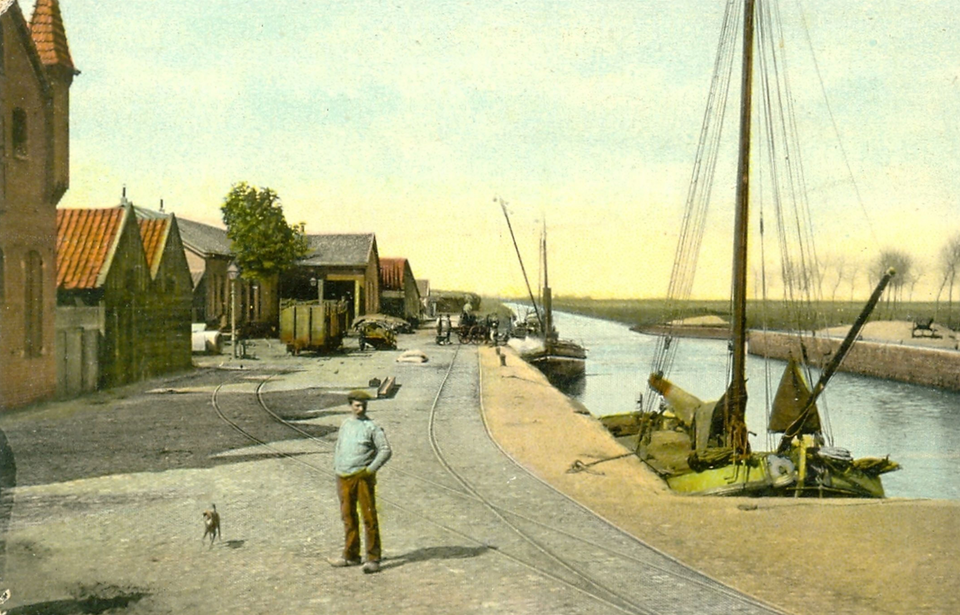Attention stone - Tram depot
Streetcar depot (1881-1937) - Gedempte Haven
On the occasion of the anniversary "Waalwijk: 100 years together," 24 attention stones were laid in the municipality. The selected objects (streetcar depot, monastery, town hall and shoe industry) in Besoijen played a role at the time of the re-division (1922). This website describes the bicycle and walking route "On Path in the Historic Langstraat" that leads past these stones.
As early as the 18th century, goods destined for Tilburg arrived at the Waalwijk port....
Streetcar depot (1881-1937) - Gedempte Haven
On the occasion of the anniversary "Waalwijk: 100 years together," 24 attention stones were laid in the municipality. The selected objects (streetcar depot, monastery, town hall and shoe industry) in Besoijen played a role at the time of the re-division (1922). This website describes the bicycle and walking route "On Path in the Historic Langstraat" that leads past these stones.
As early as the 18th century, goods destined for Tilburg arrived at the Waalwijk harbor. In the 19th century the transport of people and goods was provided by the diligence (carriage) of 'Van Gend en Loos'. On December 20, 1867, a plan was submitted to the Provincial Water Board for a narrow-gauge (1067 mm gauge) tramway connecting Waalwijk with Tilburg. On December 30, 1869, the Waalwijk City Council stipulated that the streetcar line be extended to the Waalwijk harbor. The steam streetcar to Tilburg was a cheap alternative to the emerging train. The streetcar line was realized in phases under the direction of civil engineer J. van den Elzen (Waalwijk). On July 13, 1881, the 16 km long section Tilburg - Loon op Zand - Besoijen was opened. In August, this streetcar line was extended via the Wagenstraat (now: Hugo de Grootstraat) to the port in Waalwijk. That was a great progress, because now goods and
persons could now be transported to the port via this streetcar connection. Near the port, a streetcar depot of the Hollandsche Buurtspoorwegen was built. This consisted of a shed for one locomotive, a storeroom and a dwelling cum office.
Baardwijk
In 1887 the streetcar connection 's Hertogenbosch - Baardwijk was constructed and put into operation by the Hollandsche Buurtspoorwegen. The Waalwijk city council did not tolerate a streetcar line through the 'Groote Straat'. The street was considered too narrow and too busy. The 'Groote Straat
gained national fame through the daily press, because the 'pious fathers' stubbornly refused to share streetcar traffic with this street. After interference from above (Ministry of Water Management, Trade and Industry and Council of State), a streetcar connection to Baardwijk was established in 1902. Two streetcars ran seven times a day. The streetcar line had several stops: Besoijen (railroad crossing, Besoijensche Steeg and town hall) - Waalwijk (harbor, café Max Goverts, Hoekeinde) - Baardwijk (church and Baardwijksche Overlaat). In October 1934 passenger transport stopped and at the end of 1936 goods transport stopped. By then passenger transport had already been taken over by buses of the BBA. The railroad line, the Langstraatlijn or Halve-Zolen-lijn, had already been built and provided a train connection with 's Hertogenbosch. From 1934 to 1937, Brabant steam locomotives, wagons and rails were processed into steel scrap at the depot.
Last ride
The streetcar line was discontinued in 1937, and the "Catholic Young Middle Class Association" organized the last streetcar ride: "The solemn
funeral of 't Waalwijksche stoomtrammetje'. The death house was at the Hoogeindsche bridge in the Baardwijksche Overlaat. A thousand-strong crowd was waiting for the last ride that went via the old stop café 't Vosje and a stop at hotel Verwiel
aar café Ant. van der Pluijm at the harbor. The streetcar was decorated with a wreath, black shrouds and menacing skulls, and because of the sad autumn weather, people carried umbrellas. On the streetcar were conductor, driver and stoker. The streetcar was accompanied by a constable.
